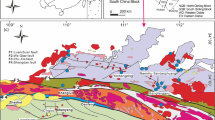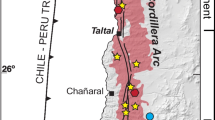Abstract
The Baisha Structure, with a rim-to-rim diameter of ~3.7 km, in the center of the Hainan Province, southern China has been considered to be an impact crater. Field investigation and petrological study are presented in this paper to investigate the impact hypothesis for this structure. The ~600-m-thick Lower Cretaceous feldspathic quartz sandstones from the Lumuwan Formation are the major outcrops both within and outside of the structure. The amphitheater-shaped rim of the structure is composed of granite porphyries that are intruded in the Lumuwan Formation. Previously interpreted impact breccia and impact melt rocks are actually granite porphyries different cooling rates and weathering status. Rocks from locations that most likely have recorded shock metamorphic signatures are sampled, but petrographic analyses reveal no indications of shock metamorphism. While subtle structural deformation occurs at the contact boundary between the granite porphyries and the feldspathic quartz sandstones, the feldspathic quartz sandstones exhibit uniformed dipping strata across the crater floor and walls. All the evidence suggests that the Baisha Structure was not formed by impact cratering. It most likely has been shaped by a combination of magmatic intrusion and long-term differential erosion.
Similar content being viewed by others
References Cited
Baratoux, D., Reimold, W. U., 2016. The Current State of Knowledge about Shatter Cones: Introduction to the Special Issue. Meteoritics & Planetary Science, 51(8): 1389–1434. https://doi.org/10.1111/maps.12678
Chen, M., Xiao, W. S., Xie, X. D., et al., 2010. Xiuyan Crater, China: Impact Origin Confirmed. Chinese Science Bulletin, 55(17): 1777–1781. https://doi.org/10.1007/s11434-010-3010-1
French, B. M., 1998. Traces of Catastrophe: A Handbook of Shock-Metamorphic Effects in Terrestrial Meteorite Impact Craters. LPI Contribution 954, Lunar and Planetary Institute, Houston. 120
French, B. M., Koeberl, C., 2010. The Convincing Identification of Terrestrial Meteorite Impact Structures: What Works, what Doesn't, and why. Earth-Science Reviews, 98(1/2): 123–170. https://doi.org/10.1016/j.earscirev.2009.10.009
Grieve, R. A. F., Langenhorst, F., Stöffler, D., 1996. Shock Metamorphism of Quartz in Nature and Experiment: II. Significance in Geoscience. Meteoritics & Planetary Science, 31(1): 6–35. https://doi.org/10.1111/j.1945-5100.1996.tb02049.x
Grieve, R. A. F., Robertson, P. B., Dence, M. R., 1981. Constraints on the Formation of Ring Impact Structures, Based on Terrestrial Data. In: Schultz, P. H., Merrill, R. B., eds., Multi-Ring Basins: Formation and Evolution. Proceedings of the Lunar Planet Science Conference, November 10–12, 1980, Houston, TX. Pergamon Press, New York and Oxford. 37–57
Hergarten, S., Kenkmann, T., 2015. The Number of Impact Craters on Earth: Any Room for Further Discoveries?. Earth and Planetary Science Letters, 425: 187–192. https://doi.org/10.1016/j.epsl.2015.06.009
Koeberl, C., Claeys, P., Hecht, L., et al., 2012. Geochemistry of Impactites. Elements, 8(1): 37–42. https://doi.org/10.2113/gselements.8.1.37
Langenhorst, F., Deutsch, A., 2012. Shock Metamorphism of Minerals. Elements, 8(1): 31–36. https://doi.org/10.2113/gselements.8.1.31
Milton, D. J., MacDonald, F. A., 2005. Goat Paddock, Western Australia: An Impact Crater near the Simple-Complex Transition. Australian Journal of Earth Sciences, 52(4/5): 689–697. https://doi.org/10.1080/08120090500170435
Wang, D. J., Li, J., 1993. The Interpretation of Remote Sensing Image of Baisha Impact Crater and Its Verification. Geology in China, (5): 23–24, 32–33 (in Chinese)
Wang, D. J., Wang, X. J., 1995. The Baisha Meteorite-Impacted Crater and Crater-Forming Meteorite in Hainan Island. Geological Science and Technology Information, 4: 17–21 (in Chinese with English Abstract)
Wang, D. J., Wang, X. J., Ding, S. J., et al., 1997. Baisha Meteorite-Impact Crater in Hainan Island. Hainan Publishing House, Haikou. 60 (in Chinese)
Wang, X. J., 1994. Impactites of Baisha Crater in Hainan: The Preliminary Study of Geochemical Characteristics. Geology in China, (6): 21–23 (in Chinese with English Abstract)
Wang, X. J., 1996. The Discovery of Calcium-Rich Chondrite in Baisha, Hainan. Geology in China, (4): 21–24, 33 (in Chinese)
Xiao, Z. Y., Chen, Z. X., Pu, J., et al., 2018. Hailar Crater—A Possible Impact Structure in Inner Mongolia, China. Geomorphology, 306: 128–140. https://doi.org/10.1016/j.geomorph.2018.01.020
Xiao, Z. Y., Zeng, Z. X., Li, Z. Y., et al., 2014. Cooling Fractures in Impact Melt Deposits on the Moon and Mercury: Implications for Cooling Solely by Thermal Radiation. Journal of Geophysical Research: Planets, 119(7): 1496–1515. https://doi.org/10.1002/2013je004560
Xu, X. M., Kenkmann, T., Xiao, Z. Y., et al., 2017. Reconnaissance Survey of the Duolun Ring Structure in Inner Mongolia: Not an Impact Structure. Meteoritics & Planetary Science, 52(9): 1822–1842. https://doi.org/10.1111/maps.12890
Yichang Institute of Geology and Mineral, Ministry of Geology and Mineral, Hainan Bureau of Geological and Mineral, 1991a. Hainan Island Geology (III) Tectonic Geology. Geological Publishing House, Beijing. 140 (in Chinese)
Yichang Institute of Geology and Mineral, Ministry of Geology and Mineral, Hainan Bureau of Geological and Mineral, 1991b. Cretaceous. In: Zhang, Z. L., Meng, F. S., Sheng, X. C., eds., Hainan Island Geology (I) Stratigraphy and Palaeontology. Geological Publishing House, Beijing. 202–204 (in Chinese)
Yin, J. J., Wang, Y. H., 2017a. The Mystery of the Footprints of “The Extraterrestrial” (I). Land & Resources, 11: 60–61 (in Chinese with English Abstract)
Yin, J. J., Wang, Y. H., 2017b. The Mystery of the Footprints of “The Extraterrestrial” (II). Land & Resources, 11: 58–59 (in Chinese with English Abstract)
Acknowledgments
The Hainan Geological Survey kindly provided support during the field trip. This study was supported by the National Natural Science Foundation of China (Nos. 41773063 and 41403053) to Zhiyong Xiao and Jiang Pu, the Fundamental Research Funds for the Central Universities, China University of Geosciences (Wuhan) (Nos. CUG180601 and CUG2018JM10), the National Natural Science Foundation of China (No. 41772050) to Long Xiao, and the Natural Science Foundation of Jiangxi Province (No. 20171BAB213027) to Cheng Huang. The final publication is available at Springer via https://doi.org/10.1007/s12583-018-0887-0.
Author information
Authors and Affiliations
Corresponding author
Rights and permissions
About this article
Cite this article
Pu, J., Xiao, Z., Xiao, L. et al. Non-Impact Origin of the Baisha Structure in Hainan Province, China. J. Earth Sci. 31, 385–392 (2020). https://doi.org/10.1007/s12583-018-0887-0
Received:
Accepted:
Published:
Issue Date:
DOI: https://doi.org/10.1007/s12583-018-0887-0




